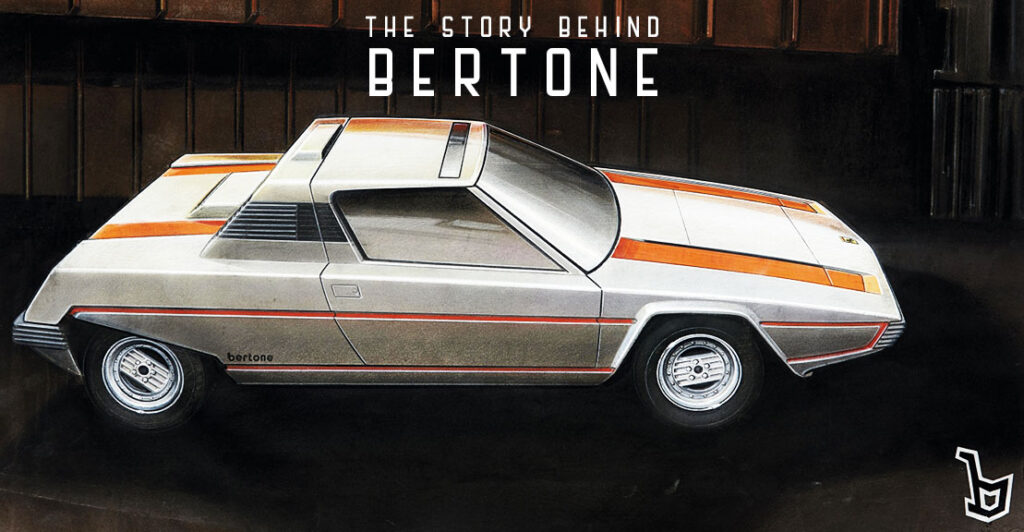
The beginning of Bertone
Bertone was founded in November 1912, when Giovanni Bertone, then aged 28, opened a workshop specialising in the construction and repair of horse-drawn carriages. He started out with three workers.
At the beginning of the 20th century cars were a rarity in Turin. The traffic on the roads was nearly all carriages, and the ones built by Bertone stood out immediately for their careful craftsmanship, sturdiness and high quality. The experts soon came to recognise the sound of a Bertone going by on the cobbled streets.
In 1914 Giuseppe, the second son in the Bertone family, was born. Everyone took to calling him Nuccio, the nickname which was to stay with him for the rest of his life, and become synonymous with Italian style throughout the world. But the joy at Nuccio’s birth was overshadowed by the outbreak of the first World War, which spelled hard times for Giovanni Bertone, who was forced to close his shop.
The end of the war, however, signalled a turning point for Bertone: the company expanded and focused its attentions on the motor-car. The new offices at number 119 Via Monginevro opened in 1920 with a workforce of 20.
A year later the first important job arrived: the construction of a Torpedo on an SPA 23S base, immediately followed by a Fiat 501 Sport Siluro Corsa, the first in a long line of high performing sports cars which would come to represent the Bertone name in the years to come.
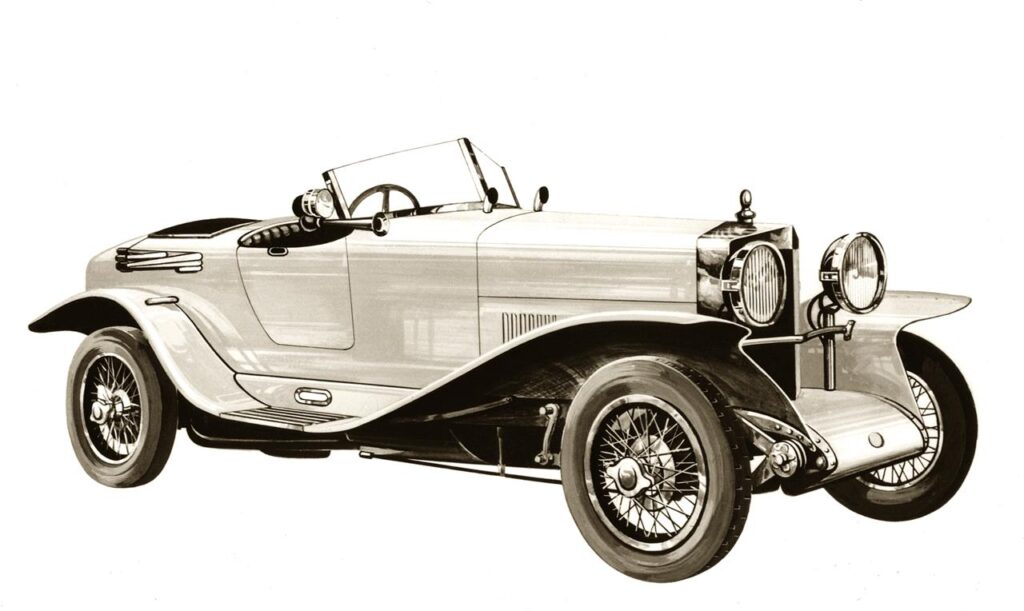
During the Twenties Bertone formed partnerships with almost all the manufacturers of the day. Turin came to represent the heart of the car industry and Giovanni Bertone began doing bodywork on Fast, Chiribiri, Aurea, SCAT and Diatto chassis. The most important partnerships, however, were those with the two biggest Turin manufacturers: Fiat and Lancia.
Vincenzo Lancia realised straight away that Giovanni Bertone was a skilled craftsman with a great future ahead of him. Affectionately nicknaming him “Bertunot“, he commissioned Bertone to create complete car bodies, above all for the limited series that the companies of the day were not always equipped to produce. This was Bertone’s first opportunity to carry out limited production of special cars on standard mechanical bases, and signalled the beginning of a great career.
And while these were great years for Bertone himself, they were also fundamental years from a styling point of view: car body shapes were slowly evolving, losing the angular shapes of previous models, with the wings starting to be joined together. Giovanni Bertone produced torpedo and saloon bodies for Fiat and Lancia, and also for Itala, Diatto and SPA. And of course he also worked on commissions for private customers eager for exclusivity. Alongside the sports models like the 1928 Ansaldo 6BS, Giovanni Bertone also designed luxury cars like the Fiat 505 Coupè de Ville and the Itala 51S, both in 1923, and the Lancia Lambda VIII Series in 1928.
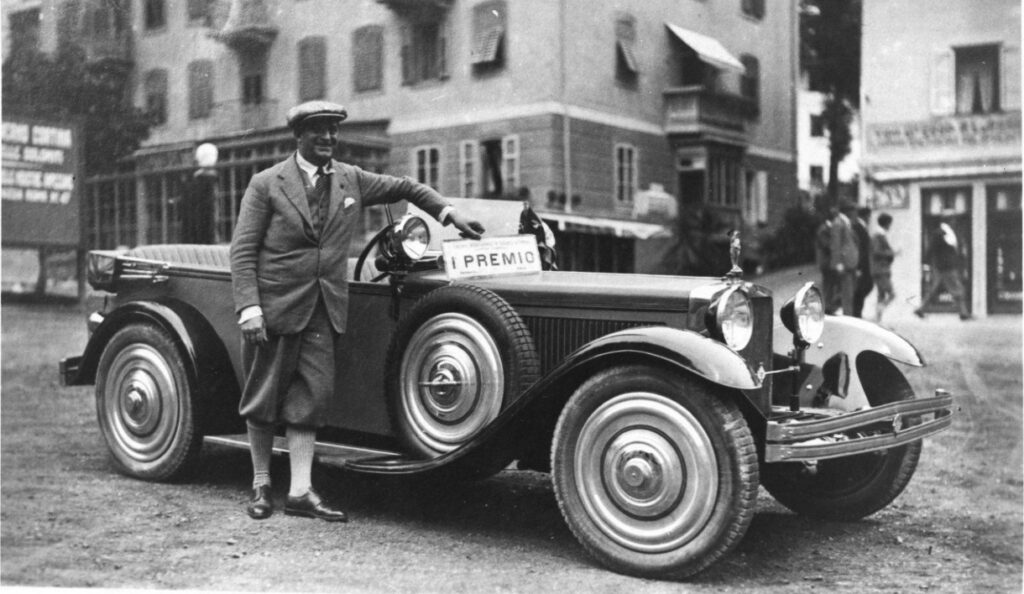
Despite the fact that the great depression of 1929 had brought many Turin carmakers to their knees, Giovanni Bertone‘s shrewd management meant that his company was able to carry on creating cars with great appeal. In 1932, for example, he designed the imposingly elegant Lancia Artena. But the most important news for the Carrozzeria came in the following year, 1933, when young Nuccio, then aged 19, officially began working in his father’s company.
In the meantime Bertone began working on commercial vehicles too, and as the business grew, new premises were needed. The company moved to 225 Corso Peschiera. There were now 50 people on the staff.
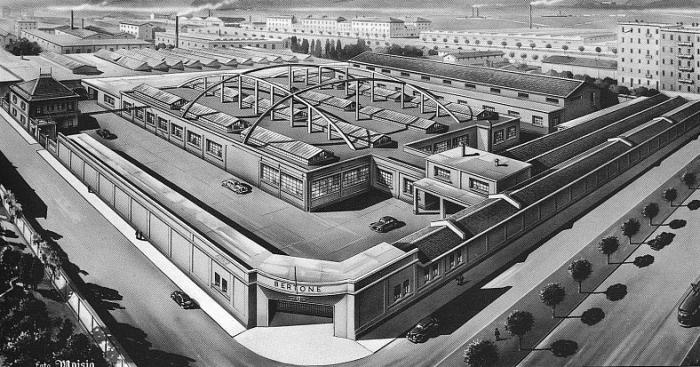
In 1934 Bertone created the extraordinary Fiat 527S Ardita 2500, which was a real turning point in car design, with some incredible new details such as the stunning front headlights with fairing along the bonnet. The Ardita signalled the start of a new kind of style, which was destined to take off towards the end of the decade, with Fiat and Lancia models which were astounding for their day. Examples were the “six window” Fiat 1500 Aerodinamica, the dignified, opulent Lancia Aprilia Cabriolet and the novel Fiat 1500 Torpedo, with constructional features that had never been seen before, such as the fold-away hood which stowed away entirely inside the car. With his bold innovations and elegant creations, Bertone was beginning to make a name for himself with critics and motoring fans alike.
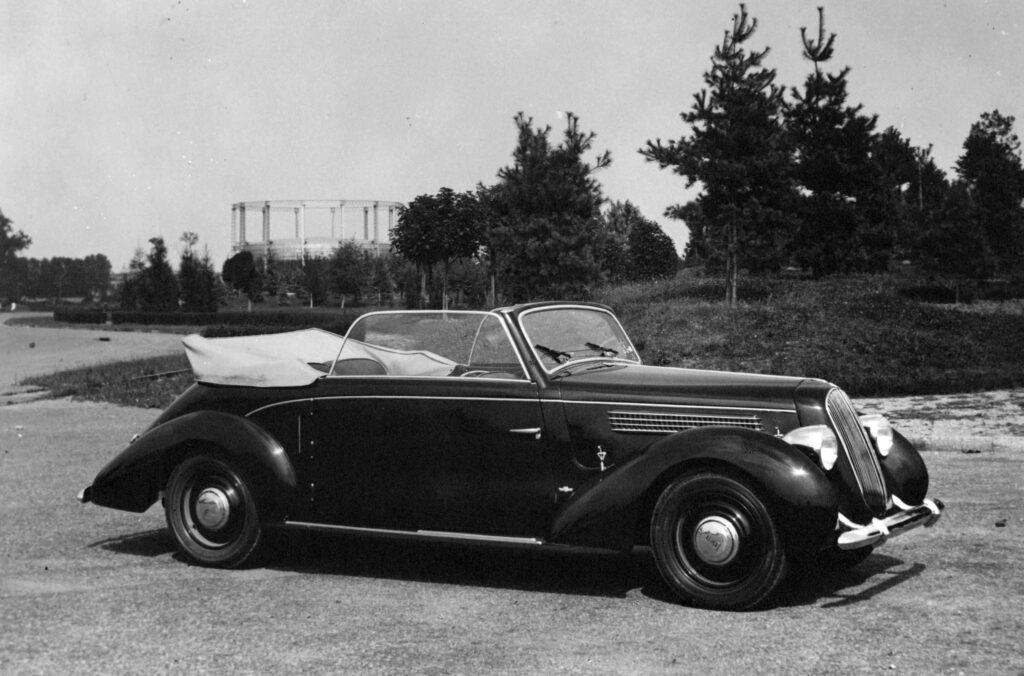
At the outbreak of World War II, the car market experienced a sudden, drastic downturn. Almost all the bodywork manufacturers, including Bertone, reacted to the crisis by turning to military vehicles of various kinds (such as the Bertone ambulance on Lancia Artena base).
But times were hard and the scarcity of work was exacerbated by the lack of raw materials and labour, which meant that it was difficult to meet orders from the army. But even with all the problems, production did not cease in the Corso Peschiera factory, with the luxurious Lancia Aprilias and the unique, extremely elegant long chassis Fiat 2800 cabriolet, the only one of its kind, built on commission for race driver and motoring journalist Giovanni Lurani Cernuschi.
After the War
After the war, as the long slow process of reconstruction began in Europe, the big industrial companies gradually upped production levels, and the bodyworks got back to work. During these difficult years Nuccio Bertone created cars like the Lancia Aprilia Cabriolet and the racing Fiat 1100 Stanguellini, cars which were precursors to some of the design trends of the following decade.
At the end of the Forties, Nuccio Bertone turned to racing, at the wheel of a number of different cars, including a Fiat 500 barchetta he built himself. At the end of the decade the meeting with Vittorio Stanguellini led to the creation of a coupé with a Fiat 1100 chassis which was to be a great success with the public.
The Fifties brought in the first orders from abroad, in particular from MG (TD Cabriolet) and Bristol in 1952. The following year Nuccio Bertone designed the prototype for the Alfa Romeo Giulietta Sprint, which was presented at the 1954 Turin Motor Show. A production of 1000 was originally planned, but in the end nearly 40,000 vehicles were made between 1954 and 1965.
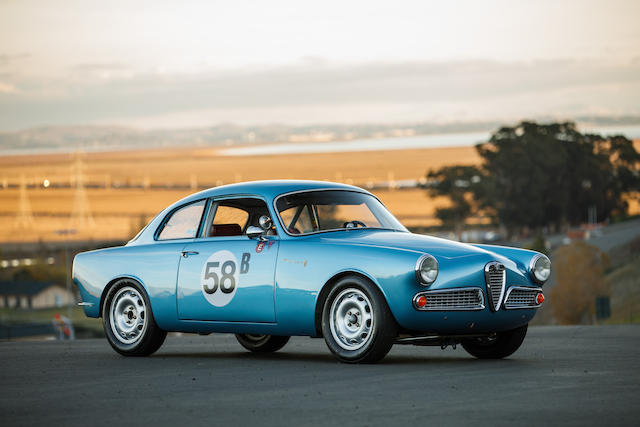
The relationship between Bertone and Alfa Romeo reached its creative peak with the Berlinetta Aerodinamica Tecnica (BAT) concept cars which pushed back the boundaries of car design and aerodynamics: the BAT 5 (1953), the BAT 7 (1954), and the BAT 9 (1955). Research into aerodynamics culminated in the production of the Abarth 750 Record in 1956, built on a Fiat 600 chassis and tested on the high speed track at Monza. This Abarth set an impressive ten world records, including doing 4,000 km at an average of 156.36 km/h and covering 10,125.26 km in 72 hours.
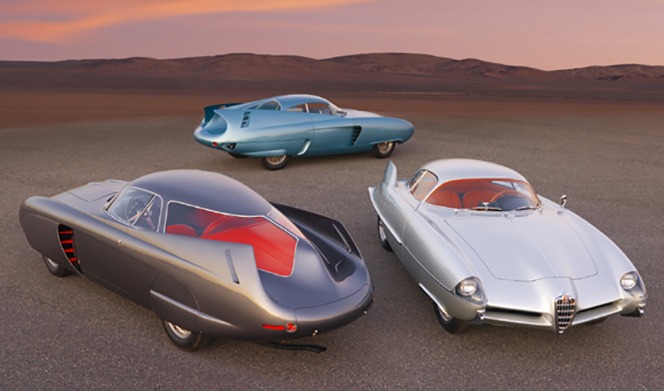
The Success
In the meantime, in 1957 the company expanded to take on the production of the NSU Sport Prinz. The factory in Corso Peschiera started to feel a little small, and work began on a new factory in Grugliasco on the outskirts of Turin. The new premises became operative in 1959, with a workforce of 550.
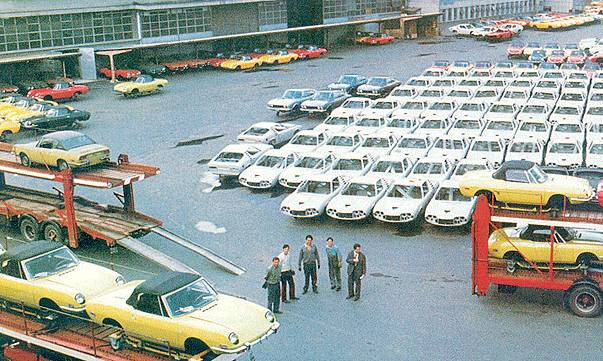
At the end of the Fifties Bertone came up with some sports berlinettas which were to make history, such as the Giulietta Sprint Special, the Aston Martin DB2/4 and the Maserati 3500 GT.
The Sixties were the years of the Italian-style GT. Nuccio Bertone came up with five variations on the theme which would always be dear to his heart, in the shape of five extremely racy GT models: the Alfa Romeo 2600 Sprint, in coupé and cabriolet versions, two Ferrari 250 GTs, one named ‘Wax’ after the commissioning client, and the other for the Maestro’s personal use, the Aston Martin DB4 GT “Jet” and the Maserati 5000 GT.
At the same time two new industrial partnerships were getting under way, with the work on the Simca 1000 Coupé and the BMW 3200 CS limited series, as was the important but unfortunate ASA 1000, better known as the “Ferrarina“, or “little Ferrari” (as the project originated with Enzo Ferrari), which, despite the high expectations of the public, never made it to the market.
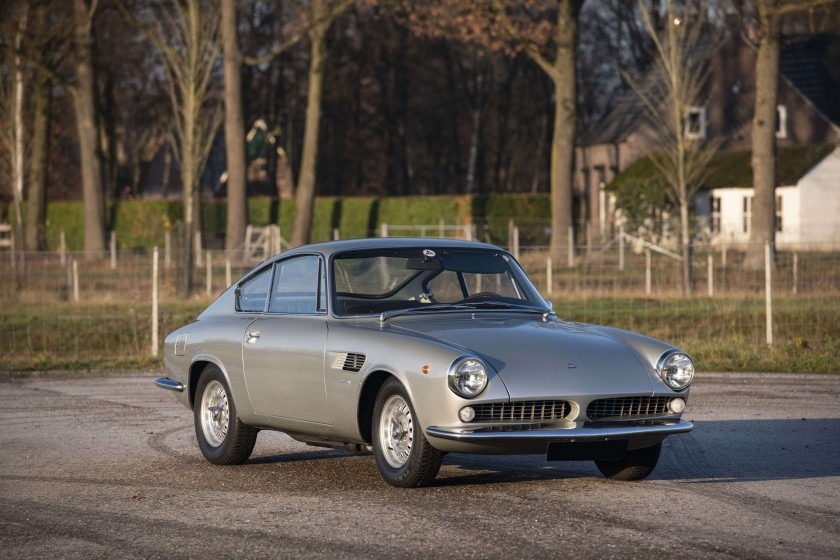
The Iso-Rivolta GT 300 and 340 and the Iso Grifo were also created in this period. Nuccio Bertone also designed a prototype cabriolet of the latter and a racing version known as the A3C. The Grifo years were also the years of the Corvair Testudo, driven personally by Nuccio Bertone to the Geneva Motor Show in 1963. The following year saw the Alfa Romeo Canguro, followed in 1965 by the Alfa Romeo Giulia GT, rightful heir of the Giulietta Sprint.
In the same year Carrozzeria Bertone experienced a major turning-point, with the launch of the Fiat 850 Spider. The commercial success of this model led Nuccio Bertone to increase the company’s production capacity to 120 units per day (between 1965 and 1972 nearly 140,000 were produced). With the 850 Spider the company took a giant leap forward in terms of production volumes, from the 13,000 bodies produced in 1966 to nearly 30,000 in 1968, an increase of 40 percent.
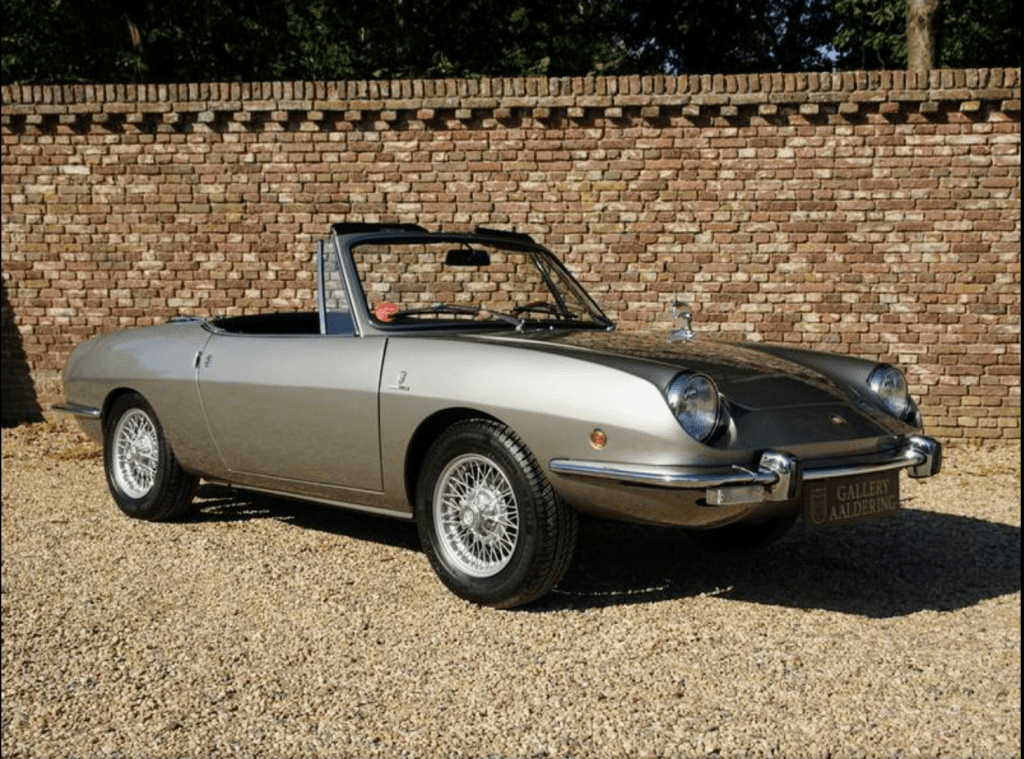
The end of the Sixties saw the beginning of the partnership with Ferruccio Lamborghini that was destined to make history in the car world. The first vehicle to come out of this was the Miura, presented at the 1966 Geneva Motor Show, which reinvented the design concept of a high performance coupé. The Miura was followed by the Marzal (1967) and the Espada (1968). In the same period two other coupés appeared: the Alfa Romeo Montreal and the Fiat Dino Coupé, both out in 1967.
Astounding, ground-breaking cars, inventing their own language for the design of the future: these were Nuccio Bertone’s trademarks. At the Paris Motor Show of 1968 he presented the Carabo concept car, which was built on an Alfa 33 chassis.
By 1970 Bertone had a workforce of 1500 and the Grugliasco factory covered an area of 267,000 sq.m. The partnership with Lamborghini led to the development of the Jarama and the Urraco. With the astounding Stratos Zero prototype, built on a Lancia Fulvia 1.6 HF base, Bertone came to represent a new point of reference in modern art, as well as on the international car design scene. The Stratos Zero, which was presented at the 1970 Turin Motor Show, went beyond mere questions of style to create a timeless blend of architecture, sculpture and industrial design.
The following year, with some of the Zero’s styling cues as a starting point, Bertone created the Lancia Stratos Stradale, a compact coupé destined mainly for the racing circuit, and which in fact went on to bring home numerous victories in various rally world championships.
In 1972, at the age of 88, Giovanni Bertone passed away. In the same year, as a kind of tacit tribute to the company’s founder, the Maserati Khamsin and the Fiat X1/9 came out. The latter, foreshadowed by the Runabout concept car, was the heir of the 850 Spider, and went on to enjoy the same runaway commercial success. Based on the Fiat 128 chassis, but with a mid-rear engine, the X1/9 went into production in 1972 and 160,000 units had been manufactured by the time production stopped in 1988.
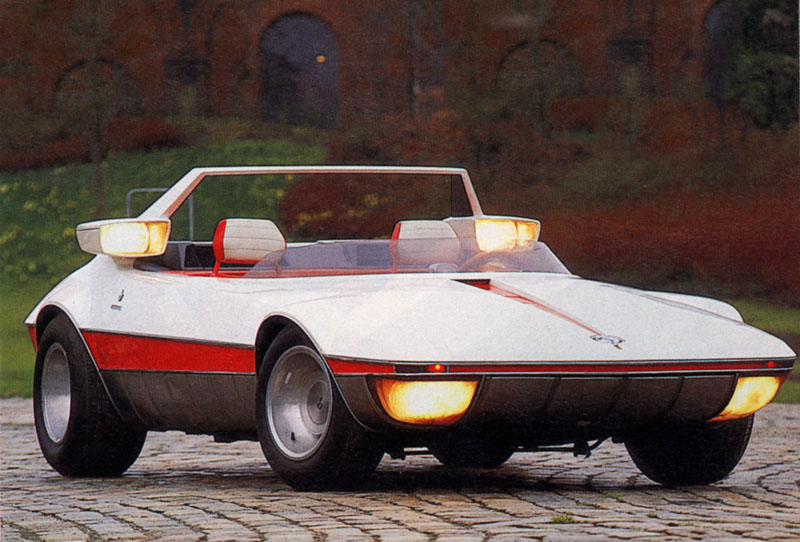
Meanwhile Nuccio Bertone‘s prolific drawing board saw a succession of supercars, runabouts and provocative style concepts: the Lamborghini Countach and the Dino Ferrari 308 GT4 (1973), the Audi 50 and Innocenti Mini 90 (1974), the Fiat 131 Abarth Rally (1975) and the prototype Alfa Romeo Navajo (1976).
In the same year, the company began working for Volvo, on the 264 TE. The Volvo 262 C, which was presented at the 1977 Geneva Motor Show, was entirely manufactured by Bertone, from the assembly of the basic body to the fitting of the mechanical components and the road trials. This procedural turning point had a big hand in transforming the company, which was now all set to become a car manufacturer in its own right.
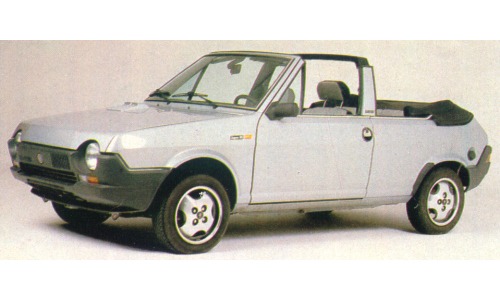
From the beginning of the Eighties the Ritmo Cabrio and the X1/9 were produced and sold directly under the Bertone marque, meaning that the company was now responsible not only for production but also for the sales network and after-sales assistance for the two models.
In 1982 Nuccio Bertone turned out another important design, the Citroen BX. After entering into a joint-venture with Volvo in 1985 the company began production of the 780, an elegant two-door saloon entirely created by Nuccio Bertone, from the formal design of the model to the full production cycle.
A new commercial agreement drawn up with General Motors Europe in 1987 saw production of the Kadett Cabrio handed over to Bertone. The partnership with Opel continued with the first generation of the Astra Cabrio, and up to the 2000’s with the new versions of the Astra Coupé and Cabriolet.
The end of the eighties saw the Citroen XM, and the Freeclimber off-roader.

Without abandoning its commitment to exploring the new languages of car design, Bertone entered the last decade of the century with its focus very much on technological innovations. Capturing the attention of public and experts alike at the 1992 Turin Motor Show was the aggressively futuristic Blitz barchetta, a showpiece which featured an electric engine and avant-garde construction solutions: a tubular chassis in special steel integrated into sandwich-structure fibre glass panels, bodywork in composite materials and carbon interiors.
In 1993 the Opel Astra Cabrio and the Fiat Punto Cabrio went into production, with the entire production cycle for both cars at the Grugliasco factory: assembly of the bodywork, fitting of the mechanical components, paintwork and fittings. A complete production cycle, ending with the final testing process, which is carried out according to the procedures and standards of the commissioning companies.
Continuing its research into low environmental-impact vehicles, in 1994 Bertone presented the ZER (Zero Emission Record), a futuristic reinterpretation of the unforgettable Abarth 750 Record. Expressly conceived and created to yield the highest performance levels in the electric car sector, the ZER (which boasts a Cx of 0.11) set the world hour speed record (199.822 km in 60 minutes), and broke the 300 km/h barrier, setting a new world speed record for electric cars (with a top speed of 303.977 km/h).
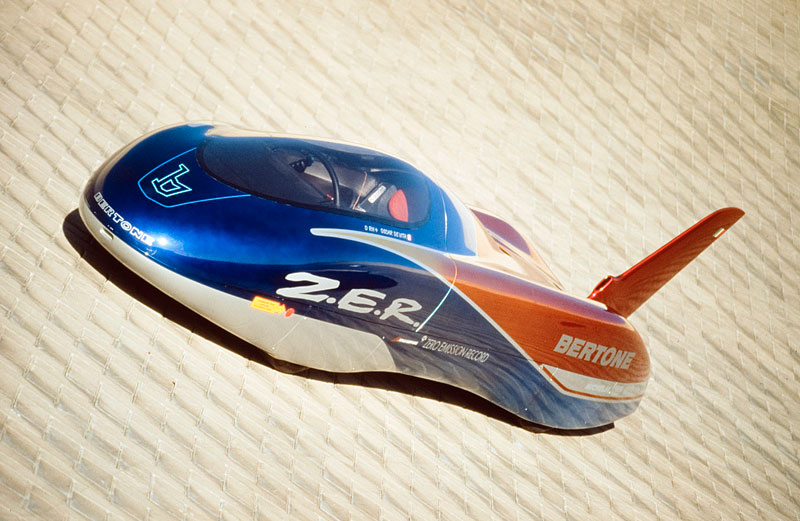
In 1994, Carrozzeria Bertone became the first manufacturer in Italy to be awarded ISO 9001 quality certification. Meanwhile Nuccio Bertone did not turn his back on a past dedicated to bodywork and continued to design working prototypes: the Karisma (1994), a four-seater berlinetta on a Porsche base, the Kayak (1995), a coupé on a Lancia K base, the Slalom “coupé de chasse” on an Opel Calibra base, and the Enduro 4×4, an SUV on a Fiat Brava floorpan.
On 26 February 1997, on the eve of the Geneva Motor Show, Nuccio Bertone passed away, leaving the world to grieve “one of the greatest coachbuilders of the century, and international Maestro of Italian style” in the touching words of Fulvio Cinti, motoring journalist and car historian.
After the passing of Nuccio Bertone, Bertone continues with an exploration of state-of-the-art technologies such as drive-by-wire. It has been manufacturing the new generation of the Opel Astra Coupé since 1999, and the Opel Astra Cabrio was added in 2000, both designed by Stile Bertone in Caprie. Bertone also produces the C1 scooter for BMW, opening a brand new chapter in the history of individual mobility.
The decline of Bertone
Fiat’s decision not to continue with the convertible version on the New Punto, however begins to create difficulties, which continued with the lost of orders from German car manufacturs and the missed agreement for the production of the Alfa Romeo GT.
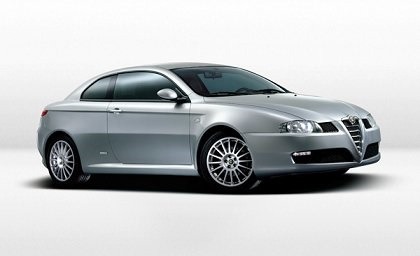
Bertone designed the New Panda in 2003, but it is the only important project of that period, together with the 2000 Mazda Neospace concept car, the 2003 Changhe Ideal for the Chinese subsidiary of Suzuki and the Chery A1 of the 2007. On the other hand, concept cars continue to flourish, essential to try to attract new customers, with an increasingly international vision. In 2000 the Slim electric car was built, in 2001 the Filo (Opel), in 2002 the commemorative Novanta (Saab 9-5), in 2003 the Birusa (BMW Z8), in 2004 the Jet2 (Aston Martin Vanquish), in 2005 the Villa (Cadillac SRX), in 2006 the Suagnà (Fiat Punto), in 2007 the Barchetta (Fiat Panda) and in 2008 the BAT 11 (Alfa Romeo 8C Competizione). The total lack of orders to feed the production lines of the Grugliasco factory, leads after the failure of several negotiations, to cede the plant to Domenico Reviglio’s Keiber Group in 2008, the operation, however, is contested by the court and Bertone declared bankrupt. The factory was subsequently purchased by the Fiat Group and transformed into the Grugliasco Automotive Workshops, where Maserati models are produced.
Lilli Bertone tries to relaunch Caprie’s Bertone Stile, under the guidance of the stylist Jason Castriota who presented the Mantide which was based on a Chevrolet Corvette ZR1. The following year, Castriota leaves Bertone, replaced by Mike Robinson, who presented the Pandion, based on a 8C Competizione in occasion of the Alfa Romeo centenary. Followed by the Jaguar B99 in 2011, the Nuccio (for the company’s centenary in 2012), and the Aston Martin Rapide Jet 2+2 for a private customer in 2013. The only order for a car manufacturer, however, was the concept car C51X car and the D50 sedan for the chinese brand BAIC : not enough to survive. In 2014, therefore, also Bertone Style closes.



